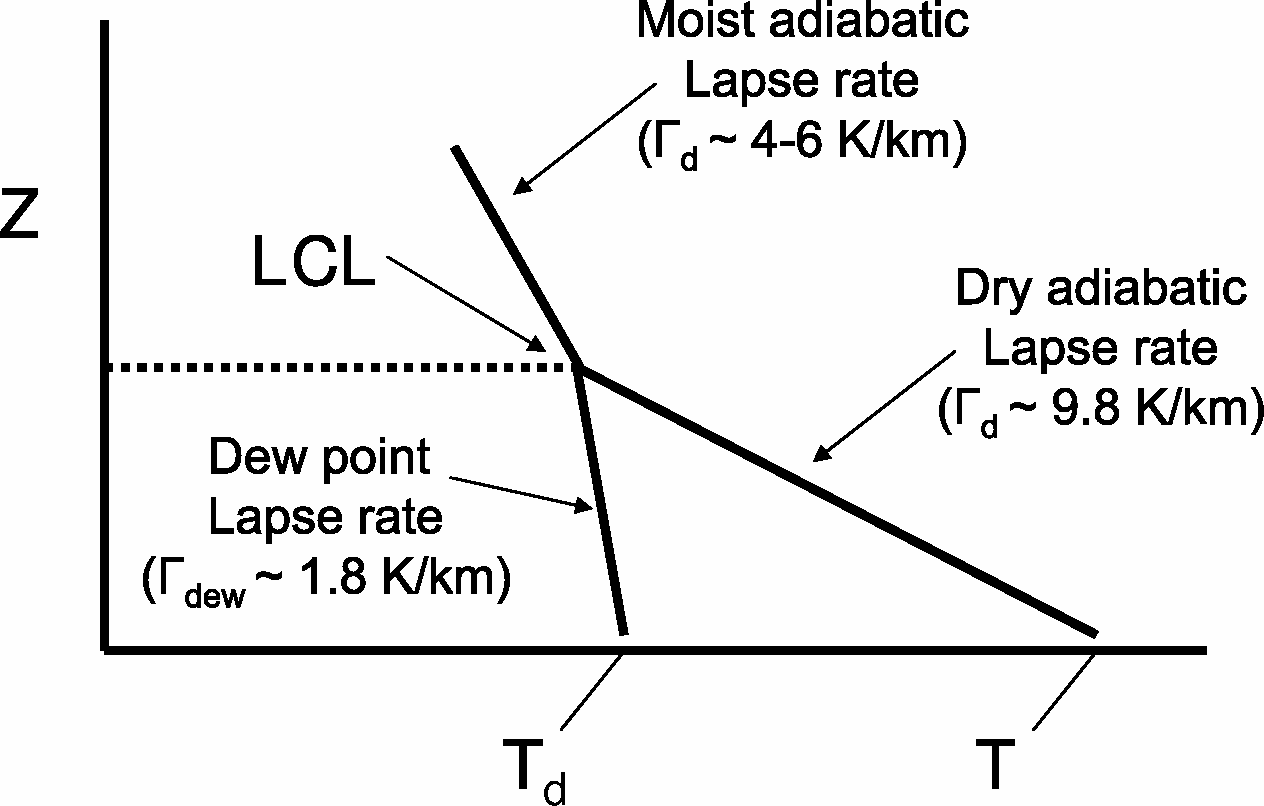Be very careful that you enter the reported surface pressure rather than the sea level pressure. Lifting Condensation Level LCL overview The Lifting Condensation Level LCL is the height at which a parcel of air lifted dry-adiabatically would become saturated.
What Is The Lifting Condensation Level At Level
If we assume that the change in dewpoint is also constant with height ie the.

. Atmospheric sciences is the Lifting Condensation Level LCL. The lifted condensation level or lifting condensation level LCL is formally defined as the height at which the relative humidity RH of an air parcel will reach 100 with respect to liquid water when it is cooled by dry adiabatic lifting. In addition six one-day case studies were completed to further understand land.
Atmospheric thermodynamics by Mick Pope Australian Bureau of Meteorology. On a thermodynamic diagram it is located at the point of intersection of the dry adiabat through the point representing the parcels original pressure and temperature and the mixing ratio line value at the original level. Equation 2 can be utilized to calculate the dewpoint at any level Tdew 3z Tdew0 Γdewz where Tdew0 is the initial dewpoint temperature at the same level as T0 and Γdew is the dewpoint lapse rate Note that although the same lapse rate principle is applied to temperature and to dewpoint the two lapse rates are far from equal.
The final input required by our LCL calculator is the surface pressure. Realizing that an air. It can be used as a reasonable estimate of cloud base height when parcels experience forced ascent.
To locate the LCL on a skew-T diagram follow a mixing ratio line up from the dewpoint then follow a dry adiabat up from the surface temperature. Output is pressure and parcel temperature at LCL. However you can also calculate the LCL conditions for an air parcel at any other pressure level by substituting the appropriate values.
As the mixing becomes deeper it will get to the point where the LCL of an air parcel starting at the surface is at the top of the mixed region. Where the two lines intersect is the lifted. Dew Point Calculator PDF Chapter 6.
The convective condensation level CCL results when strong surface heating causes buoyant lifting of surface air and subsequent mixing of the planetary boundary layer so that the layer near the surface ends up with a dry adiabatic lapse rate. The lifted condensation level LCL is the level in the atmosphere at which an air parcel that has been lifted as a dry parcel will become saturated. Stability - University of California Irvine Figure 6-2-6-Determination of the lifting condensation level.
Surface temperature surface dewpoint and surface pressure. The RH of air increases when it is cooled since the amount of water vapor in the air ie its specific humidity remains constant while the saturation vapor pressuredecreases. The pressure and temperature at the lifting condensation level are usually called the condensation pressure and condensation temperature respectively and the corresponding point on a thermodynamic diagram is called either the characteristic point adiabatic saturation point or adiabatic condensation point.
Start at the initial temperature T and pressure of the air parcel and follow the dry adiabatic lapse rate line upward provided that the RH in the air parcel is less than 100 otherwise it is already at or above LCL. The lifting condensation level height LCL m is determined from continuous surface-air observations of relative humidity and temperature as the altitude where the surface- air moisture equals saturation following a dry-adiabatic ascent. Assuming a constant dry adiabatic lapse rate with height the temperature at any level during dry adiabatic ascent can be written as T 2 z T0 Γd z where T0 is the initial temperature Γd is the dry adiabatic lapse rate and z is the vertical displacement.
It expresses the height above the ground AGL at which isentropically ascending moist humid air parcel reaches water-vapor saturation pressure or RH100. Parcel Temperature at LCL. The LCL conditions are calculated using only three atmospheric input parameters that are commonly measured and reported.
This has large consequences for the lapse rate of an air parcel and distinguishes the dry adiabatic lapse rate from the moist adiabatic lapse rate. Remember dew point temperatures are always lower than or equal to observed temperatures. Val ues are computed from surface meteorological observations for 16.
Compared to IOP 1 lifting condensation level LCL heights were also lower during IOP 2 over irrigated areas. This calculator was designed to calculate the lifting condensation level LCL for a mass of air lifted from the surface. For more information on the lifting condensation level please click here.
Enter the reported dew point temperature in degrees Celsius. The latent heat of condensation is approximately equal to 25 10 6 Jkg -1 which means that for every kg of water vapor that condenses to form liquid water 25 10 6 Joules of energy are released. This Javascript calculator was designed to calculate lifting condensation level LCL conditions using only three atmospheric input parameters that are commonly measured and reported during most local televised weather forecasts.
The Lifting Condensation Level is the level at which a parcel becomes saturated. About Press Copyright Contact us Creators Advertise Developers Terms Privacy Policy Safety How YouTube works Test new features Press Copyright Contact us Creators. This is the minimum height at which some cloud bases may be formed eg cumulus clouds as illustrated in Figure 1.
So then the initial temp is 30C not sure what it means to follow the dry adiabatic lapse rate line upwards.

Lifting Condensation Level Youtube

Lifting Condensation Level Youtube


0 Comments